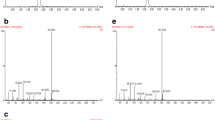Abstract
A novel microorganism was isolated which is able to produce mannitol when grown in the presence of fructose and glucose as carbon sources. In flask culture in a medium containing 150 g fructose l−1, it yielded 67 g mannitol l−1 after 168 h. In fed-batch culture with 3–12% (w/v) fructose, production reached a maximum of 209 g mannitol l−1 after 200 h, corresponding to an 83% yield and a 1.03 g l−1 h−1 productivity. The isolated strain was identified as Candida magnoliae based on identical sequences in the D1/D2 domain of its 26S rDNA and a similar carbon source utilization pattern with C. magnoliae reference strains.
Similar content being viewed by others
References
Erten H (1998) Metabolism of fructose as an electron acceptor byLeuconostoc mesenteroides. Process Biochem. 33: 735–739.
Furia TE(1972) Handbook of Food Additives, 2nd edn. West Palm Beach, FL: CRC Press.
Grobben GJ, Peters SWPG, Wisselink HW, Weusthuis RA, Hoefnagel MHN, Hugenholtz J, Eggink G (2001) Spontaneous formation of a mannitol-producing variant of Leuconostoc pseudomesenteroides grown in the presence of fructose. Appl. Environ. Microbiol. 67: 2867–2870.
Lewis DH, Smith DC (1967) Sugar alcohols(polyols) in fungi and green plants. I. Distribution, physiology and metabolism. New Phytol. 66: 143–184.
Makkee M, Kieboom APG, Bekkum HV (1985) Production methods of D-mannitol. Starch 37: 136–141.
Marina AY, Glaucia MP, Park YK (1993) Microbialtransformation of sucrose and glucose to erythritol. Biotechnol. Lett. 15: 383–388.
Meyer SA, Payne RW, Yarrow D (1998) Candida Berkhout. In:Kurtzman CP, Fell JW, eds. The Yeasts, A Taxonomic Study, 4th edn. Amsterdam: Elsevier, pp. 454–573.
Onishi H, Suzuki T (1970)Microbial Production of D-mannitol and D-fructose from glycerol. Biotechnol. Bioeng. 12: 913–920.
Rephaeli AW, Saier MH (1980) Substratespecificity and kinetic characterizationnn of sugar uptake and phosphorylation, catalysed by the mannose enzyme II of the phosphotransferase system in Salmonella typhimurium. J. Biol. Chem. 255: 8585–8591.
Van der Auwera G., Chapelle S, DeWachter R (1994) Structure of the large ribosomal subunit RNA of Phytophthora megasperma, and phylogeny of the Oomycetes. FEBS Lett. 338: 133–136.
Wong B, Perfect JR, Beggs S, Wright KA (1990) Production of the hexitol D-mannitol by the pathogenic fungus Cryptococcus neoformans in vitro and in rabbits with experimental meningitis. Infect. Immun. 58: 1664–1670.
Yun JW, Kim DH (1998) A comparative study of mannitol production by two lactic acid bacteria. J. Ferment. Bioeng. 85: 203–208.
Author information
Authors and Affiliations
Rights and permissions
About this article
Cite this article
Song, KH., Lee, JK., Song, JY. et al. Production of mannitol by a novel strain of Candida magnoliae . Biotechnology Letters 24, 9–12 (2002). https://doi.org/10.1023/A:1013824309263
Issue Date:
DOI: https://doi.org/10.1023/A:1013824309263




